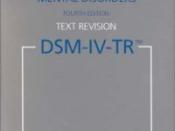In 1991, Governor William Weld modified parole regulations and permitted women to seek commutation if they could present evidence indicating they suffered from battered women's syndrome. A short while later, the Governor, citing spousal abuse as his impetus, released seven women convicted of killing their husbands, and the Great and General Court of Massachusetts enacted Mass. Gen. L. ch. 233, 23E (1993), which permits the introduction of evidence of abuse in criminal trials. These decisive acts brought the issue of domestic abuse to the public's attention and left many Massachusetts residents, lawyers and judges struggling to define battered women's syndrome. In order to help these individuals define battered women's syndrome, the origins and development of the three primary theories of the syndrome and recommended treatments are outlined below.
I. The Classical Theory of Battered Women's Syndrome and its Origins
The Diagnostic and Statistical Manual of Mental Disorders (DSM-IV), known in the mental health field as the clinician's bible, does not recognize battered women's syndrome as a distinct mental disorder.
In fact, Dr. Lenore Walker, the architect of the classical battered women's syndrome theory, notes the syndrome is not an illness, but a theory that draws upon the principles of learned helplessness to explain why some women are unable to leave their abusers. Therefore, the classical battered women's syndrome theory is best regarded as an offshoot of the theory of learned helplessness and not a mental illness that afflicts abused women.
The theory of learned helplessness sought to account for the passive behavior subjects exhibited when placed in an uncontrollable environment. In the late 60's and early 70's, Martin Seligman, a famous researcher in the field of psychology, conducted a series of experiments in which dogs were placed in one of two types of cages. In the former cage, henceforth referred...



Comment of this paper
It's a little long and sort of starts to just go on and on. on the flip side it's not bad either so i find it right about somewhere in the the middle i would gibe it 3 stars out of 5.
0 out of 0 people found this comment useful.